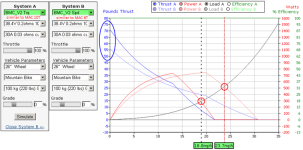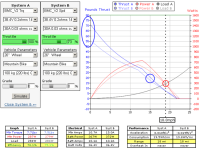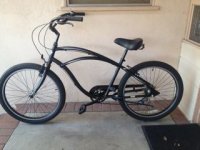psychonurse said:...for my 26" electra beach cruiser.
No disc brakes.
I plan to use either a 36v or 48v lithium battery.
psychonurse said:Yes, I have lots of stops and starts. I currently have 36v 12A.H. battery. Would like get a controller that will allow me to upgrade to a 48v 12A.H. down the line. I like having more low end torque. Not really interested in going real fast. If the bike can get to a top speed of 25mph that would be sufficient for me.
psychonurse said:My tire size is 26x2.125
Lots of clear requirements -good!psychonurse said:Not a lot of hills in my area.
Some folks don't like plots, but here's some stripped-down results that might help if you can plow though the post...
Here's a quickie run in the Grin Tech simulator comparing the Mac 8T and 10T at 36v (well, really 38.4 which is likely your mean running voltage):

So what does this mean? Well - the run was done using BMC V2S and V2T motors which are similar to the MAC 8T and 10T. The speeds at the bottom are the max that you might expect and you can see the 10T will not make 20mph on 36v. The little red circles show where the motor power curves (red) intersect the load line (black) which shows how much power is needed to push the bike to any given speed - this is where the max speed number came from (intersect means motor power = power needed to push the bike). The blue oval shows the off-the-line torque and the 10T has a clear advantage but the 8T is good as well and the gap diminishes with speed. With a bit of headwind or a slight grade these Wide Open Throttle (WOT) speeds will fall off.
Here's what you might expect after upgrading to a 48v battery:

Quite a bit zippier. Of course, you don't need to run at full throttle, and having some speed headroom so you can run at 75-80% throttle is nice.
Along those lines, here is one last run on your present 36v battery comparing a 10T running WOT and an 8T at 73% throttle so that its speed matches that of the 10T (the two power curves intersect the load line at the same point - red circle - so both motors are delivering the same power):

There are some extra tables from the simulator at the bottom with a few interesting results highlighted: the motor efficiencies, battery power (consumption), and range are essentially identical. They actually would be identical but this was as close as the throttle adjustment resolution allowed matching the speeds. So - if you get an 8T, it will give you about the same range, etc for steady running as a 10T if you back off the throttle (Ahhh - there's the rub!) at the cost of reduced torque on the low end - and of course, it will go somewhat faster if you are feeling frisky. The small blue circle shows the difference in torque at 15mph. There is not much difference so the pickup or acceleration if you goose it at 15mph will be pretty similar.
- IMHO your present 36v battery pretty much puts you in the 8T bracket to be able to comfortably run at 20+mph. This motor puts you in good place at 48v regarding your 25mph goal.
As far as the rim is concerned, since you have a 26x2.1, I think the Alex 24 CNC looks good. This would let you go up to a balloon tire later if you wish (26x2.35 Big Apple, Fat Frank) to cush out the ride and enhance the cruiser look (also should roll a little easier).

The 9FET controller is speced to get a little headroom for the 8T when you eventually upgrade to 48v (read the EM3EV comments).
In addition to the usual torque arm and C-washers, I might recommend that you pick up an ebike tester which will be a big plus in the future. Optionally, you might ask Paul to add some extra connectors to the order to match the controller and motor to make the tester connection easier. You can affix these yourself or get some assist. With the tester outfitted with connectors that match your build, you can plug it in and get answers in just a couple of minutes.


